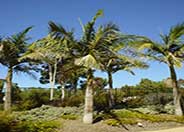
Common name:King Palm
Botanical name:Archontophoenix cunninghamiana
This is a beautiful palm which grows 40' or higher with a 10'-15' spread. The feathery leaves can grow 10' in length and are green above and gray beneath. It tolerates shade and can grow beneath tall trees for a long time if needed. It 's unique because it can be used as an indoor plant and will tolerate temperatures down to 28 degrees F.

Common name:New Zealand Flax, Wings of Gold
Botanical name:Phormium 'Wings of Gold'
The Phormium is a dwarf, growing to only 2'-3' tall. The stiff, vertical leaves are olive green in color with a yellow margin. It should be grown under full to part sun.
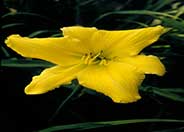
Common name:Daylily, D. Moon Hybrid
Botanical name:Hemerocallis 'D. Moon'
This Daylily has clear yellow blooms above handsome foliage. It has even bloomed in January!
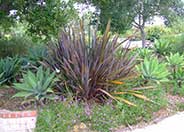
Common name:New Zealand Flax, Purple
Botanical name:Phormium tenax 'Atropurpureum'
Phormium tenax 'Atropurpureum' is an evergreen perennial. Big, dramatic plant composed of many swordlike, stiffly vertical leaves can reach 5' tall. Leaves are purple red. Flowers stems reach high above leaves, bearing clusters of 1"-2" blossoms in dark red.
Maintenance Tips
Phormium tenax 'Atropurpureum' is one of the most popular hybrids of Flax. This variety matures at 4-6' tall and wide. The leaves are strap-shaped, and deep purple, tall flower stalks appear in the summer up to 10' tall. To keep the maintenance as low as possible, plant in a location that is full sun, and well-drained and give it the space it needs to reach maturity. These plants are often the victim of poor pruning habits, with gardeners cutting the leaves off in the middle or shearing them because they are too large for the space they have been given. If this is the case, they should be transplanted to a location where they can reach their full size, or other plants around them should be moved out of their way. Old leaves rarely fall off of the plant, so removing them as they age will help keep the plant looking and performing its best.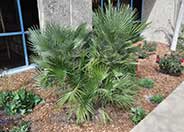
Common name:Mediterranean Fan palm
Botanical name:Chamaerops humilis
Slow growing to 20' tall but very hardy, the Mediterranean Fan palm is clump forming with rich green foliage. It can be used as a good container subject. It does best in full sun or partial shade. Petioles have sharp spines.
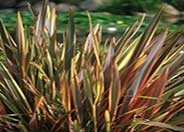
Common name:Rainbow Warrior New Zealand Flax
Botanical name:Phormium tenax 'Rainbow Warrior'
New Zealand Flax is an excellent accent plant for the garden. Evergreen leaves are long, narrow, and grow upright. Clusters of flowers grow on spikes above the foliage in late spring and summer. 'Rainbow Warrier' grows 3'-4' tall, 5'-6' wide. Leaves are darker salmon, turning cream as they age. Foliage turns deep red in winter.
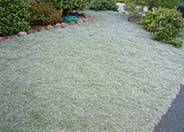
Common name:Dymondia, Rock Ditty
Botanical name:Dymondia margaretae
This foliage is gray/green/silvery; it is a very dense, mat forming ground cover. It tolerates drought, cold, salt spray and poor soils. It's deep rooted and produces small, inconspicuous yellow flowers. Rock Ditty is great for use in between stepping stones or pavers.
Maintenance Tips
Dymondia margaretae is a low, perennial ground cover that forms a very dense mat of silver-green foliage capable of choking out other plants. It stays lower than 2" tall and can spread out to 15". This is a very drought tolerant plant, but it grows much faster and thrives with regular irrigation. The most common maintenance issue with this plant is weeding. It is naturally slow-growing when it is getting established, which allows seeds and other creeping plants to emerge between the plants. Using a pre-emergent can be very effective in keeping weed seeds from germinating, but creeping plants will have to be removed by hand. Regular weeding can keep your Dymondia looking and performing its best. Once the plant has filled in, there is less space for weeds to grow, so the maintenance will decrease over time. Once established, it can creep and grow around the base of other plants. Prune it away from other plants to prevent them from being choked out.
Photographer: GardenSoft
Incorporate compost 6" into your soil to retain water, reduce compaction, feed earthworms, and provide valuable nutrients to your plants.
Attract, or buy beneficial insects such as ladybugs and lacewings to control pest outbreaks in your garden.